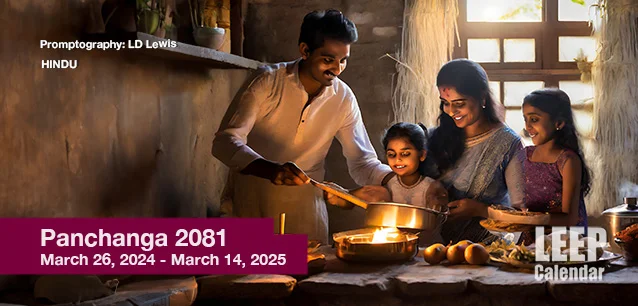 AD
AD
Today is: December 25
Scroll to explore events active on this date.
Additional Events on LEEP
LEEP INK FEATURES

August? Absolutely!
In August, we live through the Dog Days of Summer. It's hot and often humid, and those who can leave for better climates do. Down south, winter is in full force. August is also known as "the ...

In The Heat of July: July 2025 Events
Is it hot enough (or cold enough if you're below the equator) for you yet? There is actually a day for that! Like every month, I pick a diverse collection of events you may or may not know about. This ...

May Blooms: Events in May 2025
Along with October, May is one of the most densely packed months of the year. It's before the summer humidity and the last whole month of the school year. The weather is warming in t...
About the Hindu Year of Panchanga 2081
Ends: Mar 14, 2025
DESCRIPTION:
The Hindu calendar, known as "Panchanga," is a traditional Indian calendar used for religious, cultural, and astrological purposes. Unlike the Gregorian calendar, the Panchanga is based on lunar months and solar years, integrating aspects of lunar and solar cycles.
The Hindu Panchanga includes the following components:
The Panchanga aligns the solar months (Saur Maas) with the Vedic zodiac signs. The lunar aspect comprises 12 or 13 lunar months (Chandra Maas), each beginning with a new moon.
For those not accustomed to using astronomy-based mathematics to determine what day it is, the Panchanga is challenging. However, it is pivotal in Hindu cultures to choose auspicious dates for Hindu festivals, weddings, and other ceremonies. As it is based on the movement of the sun, moon, and stars, dates vary regionally across India and the globe, with each region having its version adjusted to local lunar and solar cycles. Notable variations include the Tamil, Bengali, and Malayalam calendars.
The twelve standard months of Panchanga are:
VIDEOS
SUPPORTING DOCUMENTS
Currently, this event does not have supporting documents.
ADDITIONAL IMAGES
Currently, this event does not have supporting images.
Where would you like to go now?
 AD
AD


/footer-logo.svg)
